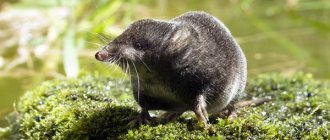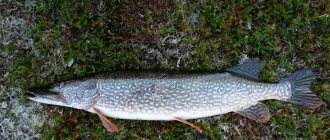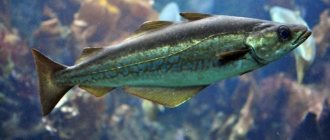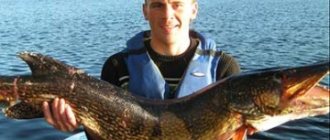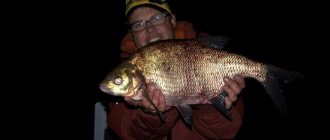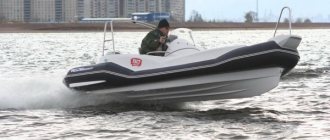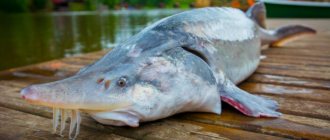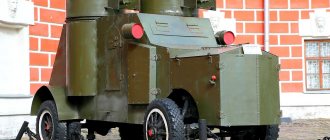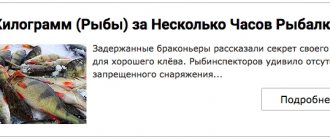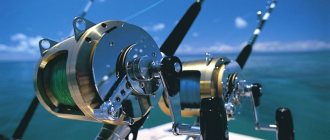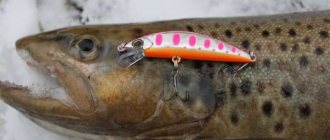Profi-Troll - everything for proper trolling Delivery throughout Russia!
Family - Salmonidae (Salmonidae) Genus - Salmo (Noble salmon) Species - Salmo salar - Atlantic salmon, salmon (Linnaeus, 1758) Morph - Salmo salar morpha Sebago - Atlantic lake salmon (first described by Girard, 1984)
Lake salmon is not an independent species or subspecies, it is a morph. Morpha is a sharply distinguished type, a phenotype within a species or its individual population. In other words, this is the same Atlantic salmon, salmon, but instead of the sea it uses lakes for feeding.
Lake salmon have a relatively higher body than anadromous sea salmon, but otherwise, in terms of external characteristics and coloring, they are practically the same, including age-related changes. Salmon fry (parr) are yellow-brown in color with an olive tint, have numerous small red and dark spots on the body, and 10–12 transverse dark stripes on the sides of the body. The color of salmon is subject to significant changes, depending on the area, and most importantly, age and time of year, but, in general, its back is bluish-gray with a few blackish spots, its belly and sides are silvery-white, its fins are more or less gray, the back and tail are darker the rest. Before spawning, salmon darken significantly; in males, in addition, red spots are shown on the sides of the body and gill covers; in very old males, even the entire belly and the anterior edges of the lower fins are painted red. At the same time, the skin of males thickens, becomes rough, and a cartilaginous process grows at the tip of the upper jaw. This whole process is called flaking. During spawning, salmon become very thin, and the head appears disproportionately large in relation to the rest of the body. The meat takes on a whitish color and becomes liquid and tasteless. Salmon is a migratory fish. However, Ladoga and Onega salmon are exceptions, because are permanent residents here.
Lake salmon, with the exception of the Shuya population of Lake Onega, are included in the Red Book of Russia (category 2 - declining numbers), fishing is prohibited everywhere except Lake Onega. Therefore, it is extremely important to learn how to clearly identify the species of caught fish, otherwise you can cause significant harm to nature and get into an unpleasant situation when meeting with fisheries inspectors.
It is difficult to confuse lake salmon with palia, which is a loach. Palia, in contrast to silver salmon, is brightly and characteristically colored, the general background is greenish, the back is darker, the sides are lighter with white and orange spots, and the belly is pink. Lake salmon and lake trout are very close to their marine anadromous forms: salmon and brown trout and differ in the same characteristics: brown trout have numerous dark spots, irregular in shape, located throughout the body, including the dorsal fin, which has 13–16 rays. In salmon, the spots on the body are few, x-shaped, below the lateral line and on the dorsal fin, as a rule, absent; there are 10–13 rays in the dorsal fin. Juvenile lake salmon live for several years in the river where they were born, growing to quite “commercial” sizes for unscrupulous fishermen. Juvenile lake trout and fully mature brook trout, the object of special attention of anglers, also live here. These three fish are very similar in shape and color. Juvenile anadromous fish are easily distinguished from brook trout by large dark elongated spots located on the sides of the body; brook trout do not have such spots or they are barely distinguishable. If you see spots, let them go! In addition, the adipose fin of lake salmon fry is gray, in trout it is orange or reddish, in juvenile salmon the caudal fin is always deeply notched and relatively large pectoral fins ending at the level of the dorsal fin.
In Russia, until recently, freshwater salmon lived in several lakes: Ladoga, Onega, Yanisjärvi, Nyuk, Segozero, Vygozero, Kuito, Kamenoye (the basin of the Baltic and White Seas). In addition, in Europe it is found in several lakes in Sweden, Finland and Norway. In North America, the natural range is much wider, covering the northeastern part of the continent, about. Newfoundland and Labrador Peninsula.
Juveniles feed on zooplankton, crustaceans, insects and their larvae; adult salmon are predators, but do not allow insects to fall into the water. The diet is dominated by vendace, smelt and three-spined stickleback; in search of accumulations of these species, salmon moves around the lake; depending on the season, the dominant position of one or another component in the salmon diet may change. Other types of fish, crustaceans, and insects are of lesser importance in nutrition. Dwarf forms retain the fry type of nutrition throughout their lives.
Lake salmon are anadromous - born in the river, grow and mature in the lake, reproduce and die in the river. Spawning occurs in autumn, at water temperatures below 8 °C. The eggs develop throughout the winter. Only at the end of spring the fry emerge from the pebble mounds - nests, and immediately begin to actively feed. In total, they spend from 2 to 4 years in the river, and before moving into the lake they gain weight from 15 to 50 g. In lakes, salmon prefer open, deep-water areas. Salmon are characterized by daily and seasonal feeding migrations. The duration of the lake feeding period before the first spawning migration is from one to nine years; there are also small males that mature and go to spawn in the same year when they roll down from the river, having spent only 3–4 months in the lake. To spawn, lake salmon return to the rivers in which they were born. There are spring and winter races, the entry into the rivers is extended, with several peaks, the specific timing of the movement varies greatly from year to year and in different reservoirs. Mature salmon that enter the river do not feed, but the instinct to grab prey remains. They rise high along the rivers, spawning grounds are located at a depth of 1–2 m, in places with a rocky bottom and fast current. The female builds a kind of nest “spawning mound”; for this she digs a hole in the current, into which she lays eggs and pours a mound of pebbles on top. Fecundity, depending on the size of the female, ranges from 4,000 to 23,000 eggs. Along with large males, dwarf males also take part in spawning; they do not go into the lakes at all, but mature directly in the river already in the second year of life. Despite the fact that lake salmon enter rivers not from salty sea waters, but from fresh lakes, and it would seem that their body does not undergo radical physiological changes, most fish still die after spawning. The surviving individuals migrate in the same autumn, some spend the winter in the river and return to the lake in the spring, where they feed together with young salmon and then go to spawn again. The majority of fish reproduce once in their life; no more than 10–30% of fish spawn again; cases of third and fourth spawning have been noted. Life expectancy is up to 10–12 years. The maximum size of lake salmon depends on the conditions in the body of water where they live. They currently reach their largest sizes (only official data are used) in the Swedish lakes Vänern and Vattern, on average 6–8 kg, often more than 10 kg; here the largest specimen in the history of observations was caught - 20.4 kg (Dennis Gustavsson, 12/21/1997, Lake Vattern). It should be noted that in the 80s, salmon in these lakes rarely exceeded a weight of 3 kg, but the joint efforts of the state and enthusiastic fishermen radically changed the situation. In Lakes Ladoga and Onega, the usual size of salmon is 4–6 kg, the maximum known size is 13–16 kg.
Since ancient times, lake salmon have been the most important fishing object for the local population. Maximum catches occurred at the end of the 19th century, when the total catch in Lakes Ladoga and Onega reached about 260 tons per year. Subsequently, the number of salmon in all lakes constantly decreased. The reasons are unregulated fishing, poaching, hydraulic construction, timber rafting, and pollution of water bodies. As a result, in 1995 lake salmon was listed in the Red Book of Karelia, and in 2001 in the Red Book of Russia; any fishing was officially prohibited. By coincidence, the decision to include lake salmon in the Red Book coincided with a significant increase in its numbers in Lake Onega, due to salmon from only one river, Shuya, which was the result of successful integrated environmental protection activities. Timber rafting has been stopped, the river is cleared of wood waste, spawning grounds are being reclaimed, artificial reproduction of salmon is being organized and juveniles are being released into the Shuya River. By Order of the Ministry of Natural Resources of the Russian Federation No. 635 of September 09, 2004, the population of the Shuya River in the Lake Onega basin was excluded from the Red Book of Russia, and since 2006, licensed recreational fishing for salmon from the Shuya population has been permitted. The restoration of numbers, albeit of one population, is undoubtedly a positive and unique event for modern Russian reality, but has created a serious problem. The salmon of Lake Onega is represented by several local populations, each of which is tied to a specific river in its breeding place, has its own biological characteristics, but outwardly it is impossible to distinguish fish belonging to different populations, therefore representatives of all populations are caught under the guise of Shuya, but they still remain in Red Book of Russia and are close to complete extinction. Lake trout, which is a constant by-catch in salmon fishing, is also listed in the Red Book of Russia.
There is no more valuable fish in Lake Onega than salmon. But right now, this property of Onego, revived and removed from the Red Book in 2004, is once again under threat of extinction. There are no fish here! The fishermen sounded the alarm. “There are no salmon in Onego!” – on fishing Internet forums not only in Karelia, but also in Russia, they began to talk about this with sadness and regret back in 2010. Nothing has changed in 2011. Salmon began to be found much less frequently than 2-3 years ago. We are, of course, talking about real salmon, that is, about specimens from 4 kg and above, those that are allowed to be caught under a license. It should be noted that there are still plenty of salmon fry. And this is understandable - after all, stocking of fish, albeit not in such volumes as before, continues. “Over the past 4-5 years, there has indeed been a significant rejuvenation of the salmon herd,” confirms scientist Alexander Lukin, representing the Karelian Institute of Water Problems of the Russian Academy of Sciences. – The fish has lost almost half of its weight. Now the average specimen weighs just over three kilograms, whereas recently the average weight of one fish was 6.2 kg. The lake is mostly inhabited by young individuals who have never spawned. The herd is maintained solely by artificial reproduction. And the main reason that fish simply do not have time to reach sexual maturity is poaching on a grandiose scale. According to employees of the Karelian Institute of Fisheries, salmon poaching alone in Lake Onega is about 100-120 tons per year. Hedgehogs They are sometimes called hedgehogs, for their similarity to a mammal. Boats with dozens of spinning rods, downriggers, boats, echo sounders, navigators and other foreign devices that allow you to catch a lot of salmon, at any depth, in any place. In recent years, there have been so many such boats and boats on Onego that you can come and have a look. This hobby is called trolling. As a rule, wealthy people engage in it, because the pleasure is not cheap. Like locusts, from May to October they travel in the direction of Petrozavodsk from Moscow, St. Petersburg, other Russian cities, and from Finland. They are bringing refrigerators and barrels for food preparations. They catch and take, as a rule, everything they get. As a rule, such fishermen do not buy licenses, and if they do buy one or two. And they are not afraid of anyone. Last year there was a case when one such St. Petersburg boat several times rammed the ship of fish inspectors trying to check documents. The inspectors had to seek protection... in our newspaper. For some reason, neither the then management of fisheries protection nor the prosecutor’s office were interested in this fact. It is not surprising that the fisheries protection department, small in number, unarmed and poor, simply does not get involved with such fishermen and, even more so, prefers not to fine them. Why weren't they warned? Trolling is just one of the reasons why salmon are disappearing. Another one is local fishing enthusiasts who are far from trolling. Salmon are caught in nets, garves, sakis and other fishing gear. Take Logmozero, through which salmon go from Lake Onega to Shuya to spawn. The local population knows when the fish is coming and waits for it, organizing numerous obstacles. At the same time, fishery inspectors are not able to keep track of all poachers, or do not want to do so. In this regard, we recall the attempts of members of the public organization “Karelian Fishermen’s Club” to participate in the fight against poaching together with inspectors in 2009 and 2010. However, for some reason, the help of social activists frightened some ordinary fisheries protection employees; they refused it. During one of the joint raids with fisheries protection, club members witnessed an interesting picture. Social activists, together with inspectors, unexpectedly changed the previously planned route and arrived to remove poacher’s nets at that same Logmozero. Indignant local men immediately ran up to the inspectors, shouting: “Why didn’t they warn you that you were coming?” The inspectors just shrugged their shoulders dejectedly.
The fish rots from the head There is another possible reason for the gradual disappearance of salmon - the participation of government representatives in this process. Over the past couple of years, the editors have repeatedly received information from both amateur fishermen and simply caring people. People complained about lawlessness on the part of the authorities. So, back in 2009-2010, residents of the village of Suisar told us that at one of the salmon spawning runs there was a boat with the inscription “Ministry of Internal Affairs” on duty, which chased the local population, not allowing them to fish in their favorite places. According to people, the main poachers in this place are precisely these defenders. “They have networks there,” said the village residents. There are, according to them, even huts where state illegal fishermen from the security forces, and possibly other departments, live. People also said that salmon were caught there by machines. Whether this is true or not is difficult to say, but it does not seem like empty slander. Federal participation in such looting cannot be ruled out. The former head of the republic, and now senator from Karelia Sergei Katanandov, who at one time was actively involved in this issue, only confirmed our assumptions. “The fight for our salmon has been going on for a long time,” he said. – I will say more, salmon is one of the main goals of those people who wanted to weaken the influence of our region on fish resources, who changed the Karelian heads of fisheries protection last year. They simply removed fish protection in this way to make it possible to rob our fish stocks. At the same time, our police turned a blind eye to this all the time. My question is - why? There is no doubt that there are people who make very good money from our salmon. It is also obvious that we ourselves cannot solve this problem. The Law of the Drawbar Fishermen and trolling enthusiasts also have their own truth.
Many of them are willing to pay for civilized fishing. However, conditions have now been created in Onego that make it impossible to fish there legally. In Lake Onega there is now a system of fishing grounds (FPU). They have been saying for a long time that it is unacceptable for such a body of water. But things, as they say, are still there. “Today, the creation of a fishing facility for catching the most valuable species of fish in Onego is a commercial absurdity,” says entrepreneur Oleg Dyakin, who has been involved in fishing tourism for 10 years. – With such a system, all fishing on Lake Onega (we are talking about salmon fishing - editor's note) is automatically made illegal. What is RPU? This is a piece of lake, relatively speaking, five by two km. Trolling in such a square is impossible. The RPU system can only exist where there are definitely fish, and in Lake Onega it is not a fact that there will be fish at a particular RPU. So you have to break it. “We just need to return to the system that existed in 2004,” the entrepreneur is sure. “Then the water area of Lake Onega was determined to be 100 by 20 km from Petrozavodsk to the Leningrad region, where, having purchased a license, it was possible to fish. Plus, Dyakin is sure that fish stocks should be urgently restored. “One plant for the reproduction of fry near Petrozavodsk is enough to ensure that there is enough fish for everyone in Lake Onega,” the businessman is sure. “But no one needs this now.” Nothing is being done. Vyacheslav Movchan, head of the Federal State Institution Karelrybvod, does not entirely agree with this opinion. - Something is still being done. This year we plan to release 305 thousand salmon fry into Lake Onega. But today we are held back by the organizational part. Previously, there was a single complex - science, fish conservation, reclamation of reservoirs, and so on. Now the single chain of management has been destroyed. The conclusion from all that has been said is simple - the state, in particular the republican authorities, prefers not to see what is happening today on Lake Onega. The situation is left to chance, there is no effective control. The laws are aimed only at collecting fines. The herd of Onega salmon, which could become a real brand of Karelia, is becoming smaller and dying. And this is happening against the backdrop of loud statements about the development of tourism.
Fish “Lake salmon” photo and description
Latin name:
Salmo salar morpha sebago
Family:
Salmonidae
Genus:
Noble salmon
Type:
freshwater
Lifestyle:
pelagic
Diet type:
carnivorous
Habitat:
Baltic Sea basin
Description:
Lake salmon is not an independent species or subspecies, it is a morph (morph is a sharply distinguished type, a phenotype within a species or its individual population, examples: albinos and melanistic vertebrates; seasonal, local forms of insects, fish, etc.). In other words, this is the same Atlantic salmon, salmon, but instead of the sea it uses lakes for feeding.
Appearance:
The body is powerful, torpedo-shaped, slightly laterally compressed. The scales are tight-fitting and small. Color changes with age. Juvenile salmon is also called “parr” - it has 10-12 transverse dark spots on the sides of its body, between which there are numerous small red and dark spots; this color makes it hardly noticeable in clear water against the background of a rocky bottom. When entering the sea, salmon acquires a protective pelagic coloration - the body is silver, the back is dark, the belly is light, camouflaging it in the thickness of the sea water. Fish that enter the river to spawn undergo mating changes - the body darkens, red and orange spots appear, males have enlarged teeth, jaws become deformed, and a characteristic hook-shaped growth forms at the end of the lower jaw.
Lake salmon have a relatively higher body than anadromous sea salmon, but otherwise, in terms of external characteristics and coloring, they are practically the same, including age-related changes. Salmon fry (parr) are yellow-brown with an olive tint, have numerous small red and dark spots on the body, and 10-12 transverse dark stripes on the sides of the body. When entering the lake, salmon, as in the sea, acquires a pelagic coloration - the body is silver with a few X-shaped spots, the back is darker, the belly is lighter. Before spawning, all the typical mating changes appear - the body darkens, red and orange spots appear, males have enlarged teeth, jaws become deformed, and a hook-shaped growth forms at the end of the lower jaw.
Characteristics that distinguish lake salmon from co-occurring salmonids: lake trout (Salmo trutta morpha lacustris), brook trout (Salmo trutta morpha fario) and trout (Salvelinus lepechini).
Lake salmon, with the exception of the Shuya population of Lake Onega, are included in the Red Book of Russia (category 2 - declining numbers), fishing is prohibited everywhere except Lake Onega. Therefore, it is extremely important to learn how to clearly identify the species of caught fish, otherwise you can cause significant harm to nature and get into an unpleasant situation when meeting with fisheries inspectors.
It is difficult to confuse lake salmon with palia, which is a loach. Palia, in contrast to silver salmon, is brightly and characteristically colored, the general background is greenish, the back is darker, the sides are lighter with white and orange spots, and the belly is pink.
Lake salmon and lake trout are very close to their marine anadromous forms: salmon and brown trout, and differ in the same characteristics: “trout have numerous dark spots, irregular in shape, located throughout the body, including the dorsal fin, which has 13-16 rays. In salmon, the spots on the body are few, x-shaped, below the lateral line and on the dorsal fin, as a rule, absent; there are 10-13 rays in the dorsal fin.”
Juvenile lake salmon live for several years in the river where they were born, growing to quite “commercial” sizes for unscrupulous fishermen. Juvenile lake trout and fully mature brook trout, the object of special attention of anglers, also live here. These three fish are very similar in shape and color. Juvenile anadromous fish are easily distinguished from brook trout by large dark elongated spots located on the sides of the body; brook trout do not have such spots or they are barely distinguishable. If you see spots, let them go! In addition, the adipose fin of lake salmon fry is gray, in trout it is orange or reddish, in juvenile salmon the caudal fin is always deeply notched and relatively large pectoral fins ending at the level of the dorsal fin.
Habitat and behavioral characteristics:
In Russia, until recently, freshwater salmon lived in several lakes: Ladoga, Onega, Yanisjärvi, Nyuk, Segozero, Vygozero, Kuito, Kamenoye (the basin of the Baltic and White Seas). In addition, in Europe it is found in several lakes in Sweden, Finland and Norway. In North America, the natural range is much wider, covering the northeastern part of the continent, about. Newfoundland and Labrador Peninsula.
Salmo salar morpha sebago, a silvery lake-river species with black spots on the back, which came to Onega from the Baltic Sea. The favorite food of salmon in the lake is smelt and vendace. The weight reaches up to 15 kg, although usually, when trolling, salmon weighing 3-5 kg are caught; it also goes well in nets and nets by topwater at depths. Favorite habitat depths are 40-70 meters, but young salmon weighing 2-4 kg are found near the shore. On Lake Onega, it is precisely because of this that a number of the coastline is closed for setting nets in the fishing rules of Karelia. Spawns in late autumn in rivers at water temperatures from 6 to 2 degrees. on riffles with depths of up to 2 meters, at this moment it can be taken with a spear both day and night with a flashlight). Small red caviar. For lovers of trolling, salmon is of greatest interest on Onega due to the salmon’s active resistance to the fisherman.
Nutrition Features:
Juveniles feed on zooplankton, crustaceans, insects and their larvae; adult salmon are predators, but do not allow insects to fall into the water. The diet is dominated by vendace, smelt and three-spined stickleback; in search of accumulations of these species, salmon moves around the lake; depending on the season, the dominant position of one or another component in the salmon diet may change. Other types of fish, crustaceans, and insects are of lesser importance in nutrition. Dwarf forms retain the fry type of nutrition throughout their lives.
Reproduction:
Lake salmon are anadromous - born in the river, grow and mature in the lake, reproduce and die in the river. Spawning occurs in autumn, at water temperatures below 8 °C. The eggs develop throughout the winter. Only at the end of spring the fry emerge from the pebble mounds - nests, and immediately begin to actively feed. In total, they spend from 2 to 4 years in the river, and before moving into the lake they gain weight from 15 to 50 g. In lakes, salmon prefer open, deep-water areas. Salmon are characterized by daily and seasonal feeding migrations. The duration of the lake feeding period before the first spawning migration is from one to nine years; there are also small males that mature and go to spawn in the same year when they roll down from the river, having spent only 3-4 months in the lake. To spawn, lake salmon return to the rivers in which they were born. There are spring and winter races, the entry into the rivers is extended, with several peaks, the specific timing of the movement varies greatly from year to year and in different reservoirs. Mature salmon that enter the river do not feed, but the instinct to grab prey remains. They rise high along the rivers, spawning grounds are located at a depth of 1-2 m, in places with a rocky bottom and fast current. The female builds a kind of nest “spawning mound”; for this she digs a hole in the current, into which she lays eggs and pours a mound of pebbles on top. Fecundity, depending on the size of the female, ranges from 4,000 to 23,000 eggs. Along with large males, dwarf males also take part in spawning; they do not go into the lakes at all, but mature directly in the river already in the second year of life. Despite the fact that lake salmon enter rivers not from salty sea waters, but from fresh lakes, and it would seem that their body does not undergo radical physiological changes, most fish still die after spawning. The surviving individuals migrate in the same autumn, some spend the winter in the river and return to the lake in the spring, where they feed together with young salmon and then go to spawn again. The majority of fish reproduce once in their life; no more than 10-30% of fish spawn again; cases of third and fourth spawning have been noted. Life expectancy is up to 10-12 years.
The maximum size of lake salmon depends on the conditions in the body of water where they live. They currently reach their largest sizes (only official data are used) in the Swedish lakes Vänern and Vattern, on average 6-8 kg, often more than 10 kg; here the largest specimen in the history of observations was caught - 20.4 kg (Dennis Gustavsson, 12/21/1997, Lake Vattern). It should be noted that in the 80s, salmon in these lakes rarely exceeded a weight of 3 kg, but the joint efforts of the state and enthusiastic fishermen radically changed the situation. In Lakes Ladoga and Onega, the usual size of salmon is 4-6 kg, the maximum known is 13-16 kg.
Current state of the species
Since ancient times, lake salmon have been the most important fishing object for the local population. Maximum catches occurred at the end of the 19th century, when the total catch in Lakes Ladoga and Onega reached about 260 tons per year. Subsequently, the number of salmon in all lakes constantly decreased. The reasons are unregulated fishing, poaching, hydraulic construction, timber rafting, and pollution of water bodies. As a result, in 1995 lake salmon was listed in the Red Book of Karelia, and in 2001 in the Red Book of Russia; any fishing was officially prohibited.
By coincidence, the decision to include lake salmon in the Red Book coincided with a significant increase in its numbers in Lake Onega, due to salmon from only one river, Shuya, which was the result of successful integrated environmental protection activities. Timber rafting has been stopped, the river is cleared of wood waste, spawning grounds are being reclaimed, salmon are being artificially reproduced and juveniles are being released into the Shuya River. By Order of the Ministry of Natural Resources of the Russian Federation No. 635 of September 09, 2004, the population of the Shuya River in the Lake Onega basin was excluded from the Red Book of Russia, and since 2006, licensed recreational fishing for salmon from the Shuya population has been permitted. The restoration of numbers, although of one population, undoubtedly a positive and unique event for modern Russian reality, has created a serious problem. The salmon of Lake Onega is represented by several local populations, each of which is tied to a specific river in its breeding place, has its own biological characteristics, but outwardly it is impossible to distinguish fish belonging to different populations, therefore representatives of all populations are caught under the guise of Shuya, but they still remain in Red Book of Russia and are close to complete extinction. Lake trout, which is a constant by-catch in salmon fishing, is also listed in the Red Book of Russia.
FISH CATALOG
